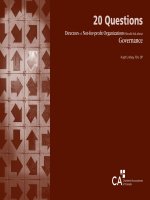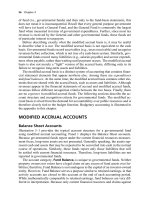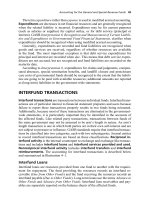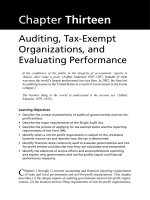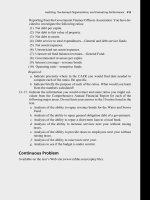Ch04 introduction nongovernment not for profit organizations
Bạn đang xem bản rút gọn của tài liệu. Xem và tải ngay bản đầy đủ của tài liệu tại đây (139.74 KB, 30 trang )
CHAPTER 4
Nongovernment
Not-for-Profit
Organizations
1
Learning Objectives
• Be able to:
– Identify a nongovernmental not-for-profit
organizations
– Understand the GAAP pertaining to
nongovernment not-for-profit organizations
including FASB Standards 116, 117, 124, and 136
2
Learning Objectives [cont’d]
• Explain the accounting and reporting criteria
for nongovernment not-for-profit
organizations
• Apply nongovernment not-for-profit
accounting and reporting requirements to
record transactions
• Distinguish reporting for health care
organizations from other not-for-profit
organizations
3
Not-for-Profit Organization
Characteristics
• Revenues received from providers who do
not expect economic benefits in return
• Operating purposes of the organization are
other than to make a profit
• Defined ownership interests are absent
4
In contrast, Government
Characteristics
• Government must have one of the following
– Popular election of officers or appointment by
officers by state or local government
– Potential for dissolution by government with
assets reverting to government
– Power to enact and enforce a tax levy
• Nongovernment organizations are all those
except governmental organizations
5
Types of Not-for-profit (NFP)
Organizations
• Four major types include
–
–
–
–
Voluntary health and welfare organizations
Colleges and universities
Hospitals and other health care entities
Other not-for-profit organizations such as social
organizations, associations, foundations,
political parties, museums, public broadcasting
stations, civic organizations, etc.
6
Not-for-profit (NFP) GAAP
• 1979 - FASB assumed authority for setting
accounting and reporting standards for
nonbusiness (NFP) organizations.
• 1984 - GASB was given authority to set
accounting and reporting standards for state
and local governments including
governmental not-for-profits
7
GAAP Hierarchy Table Nongovernment
Hierarchical Level
FASB statements and interpretations, APB opinions
A
and AICPA ARBs
FASB technical bulletins and AICPA industry audit
B
and accounting guides and SOPs if cleared FASB
AICPA practice bulletins cleared by FASB and
C Emerging Issues Task Force (EITF) consensus
positions
D
AICPA accounting interpretations, FASB
implementation guides, and industry practices that
are widely recognized or prevalent
8
GAAP Hierarchy Table
-Government
Hierarchical Level
GASB statements, AICPA and GASB
A pronouncements made specifically applicable
by GASB
GASB technical bulletins and AICPA industry
B audit and accounting guides; SOPs if made
specifically applicable and cleared by GASB
AICPA practice bulletins cleared by GASB; EITF
C
consensus positions, if GASB creates a group
GASB implementation guides and industry
practices -- widely recognized or prevalent
9
FASB NFP Guidance
• SFAS 93 Recognition of Depreciation by Not-forProfit Organizations
• SFAS 116 Accounting for Contributions Received
and Contributions Made
• SFAS 117 Financial Statements for Not-for-Profit
Organizations
• SFAS 124 Accounting for Certain Investments Held
by Not-for-Profit Organizations
• SFAS 136 Transfer of Assets to a Not-for-Profit
Organization or Charitable Trust that Raises or Hold
Contributions for Others
10
SFAS No. 93 Depreciation
• Not-for-Profit must
– Record depreciation expense for the period
– Report balances of major classes of depreciable
assets at balance sheet date
– Report accumulated depreciation of major
classes of depreciable assets at balance sheet
date
– Report method used in computing depreciation
for major classes of depreciable assets
11
SFAS No. 116 Contributions
• Contributions, gifts, and unconditional pledges are
recognized as revenues at fair value in the period
received
• Contributions made are recognized as expenses at
their fair values in the period made
• Promises to give conditional on a future event, are
recognized when the condition is satisfied
12
SFAS No. 116 Contributions [cont’d]
• Distinction is made between unrestricted and
donor stipulated restrictions on
contributions (temporarily restricted or
permanently restricted)
• Contributions of services recognition criteria
– Create or enhance nonfinancial assets
– Require specialized skills
– Provided by individuals who possess specialized
skills
– Would typically need to be purchased if donated
13
SFAS No. 117
Financial Reporting
• Financial Statements
–
–
–
–
Statement of Financial Position
Statement of Activities
Statement of Cash Flows
VHWO report additional expense schedule with
both functional and natural classification
14
SFAS No. 117 [cont’d]
• Classification of organization’s net assets
based on presence or absence of donorimposed restrictions.
• Statement of Cash Flows [SFAS 95] amended
to extend provisions to NFPs and financing
activities include new endowment gifts
15
SFAS No. 124 Investments
• Equity and debt securities reported at fair
value rather than cost or market
• Losses on restricted investments absorbed
by temporarily restricted net assets if
available. If not available, unrestricted net
assets report the loss in the statement of
activities
16
SFAS No. 136
Resources Held by Others
• Resources received reported as revenue if
recipient organization can determine
resource usage I.e., variance power
• Without variance power, resources are held
in trust for others accounted for as an asset
and a liability – no revenue is recognized
17
NFP GAAP Guidance in Progress
• NFP combinations
– Purchase methodology would apply
– Fair value is basis of the recognition
– Presume that if consideration is greater than fair
value, goodwill is recognized
– Presume that if consideration is less than fair
value, a contribution is recognized
18
Net Assets Classes
• Permanently restricted assets-principal must be
held in perpetuity and only the income may be used
• Temporarily Restricted-limited by donor imposed
stipulations such as time or purpose. When
restriction are met, the resources are reclassed to
unrestricted net assets
• Unrestricted net assets-are all assets not
permanently or temporarily restricted by donor
imposed stipulations.
19
Transactions Types
• Exchange Transactions - reciprocal transfers in
which each party received and sacrifices something
of approximately equal value
• Nonexchange Transactions - an unconditional
transfer of cash or other assets to an entity or a
settlement or cancellation of liabilities in a
voluntary non-reciprocal transfer by another acting
as other than an owner.
20
Restricted versus Unrestricted
• Only donors have the right to restrict not-for-profit
resources
• External and internal parties, other than a donor,
can designate, reserve, or allocate resources
• Restrictions are not conditions as restrictions may
be satisfied by NFP organization actions.
21
Conditional versus Unconditional
Contributions
• Conditional contributions depend on a
specified future and uncertain event to bind
the promissor.
• Unconditional contributions are
nonexchange transactions that is recognized
upon receipt
– May involve a cash payment
– May be a promise to give
22
Promises to Give
• Promise substantiated by sufficient evidence in the
form of verifiable documentation are recognized net
of any estimated uncollectable portion
• Also referred to as pledges
• May be
– Restricted – permanently or temporarily
restricted net asset revenue
– Unrestricted – unrestricted net asset revenue
• If restriction met in same year as resources are
received, may be originally recognized as
unrestricted
23
Noncash Contributions
• Contributions (gifts in kind) are recognized at
fair value when received
• Contributions are reported as program
expense or cost when items are consumed
24
Collections or Historic Treasures
• Works of art or historical treasures need not
be recognized as revenues and capitalized if
donated items are added to collections held
for public exhibition and education, cared for
and are not used for financial gain
• Disclosures required for collection items not
capitalized.
25
